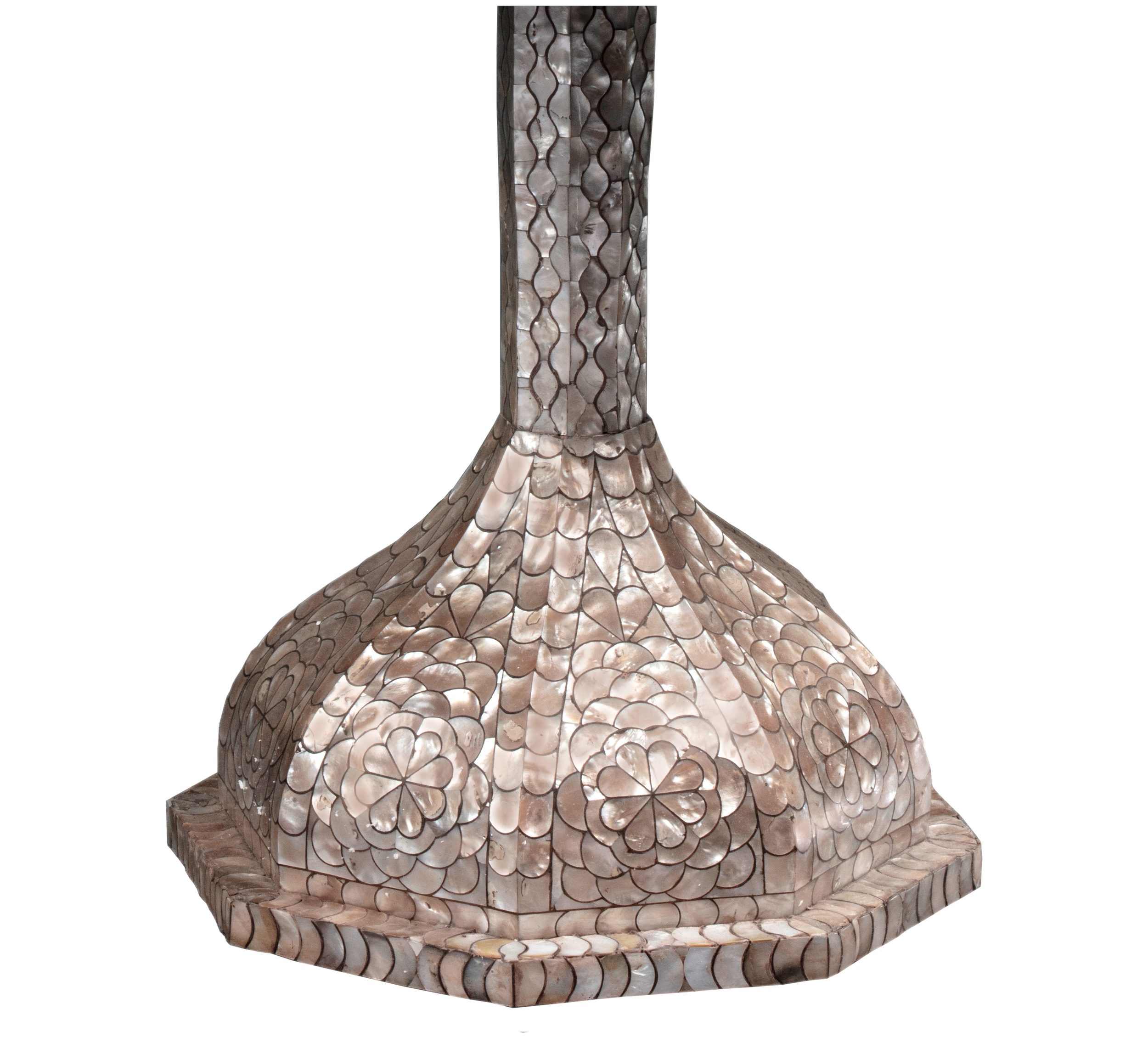SPANISH COLONIAL, 18th Century
Mother of Pearl Inlaid Wooden Occasional Table
27 ½ x 28 inches (69.9 x 71.1 cm)
This occasional table is a remarkable example of the luxurious furniture popular during the 17th and 18th centuries in Colonial Latin America. The decorative technique that creates such a striking opalescent finish on the table is known as enconchado. The term derives from concha, the Spanish word for shell, and consists of the application of small pieces of mother-of-pearl on wooden surfaces, often enhanced by lacquer filament insets between each fragment. In our table, the mother-of-pearl has been delicately arranged into concentric bands of petals alternating with rows of rosettes that repeat outwards from a fleuron at the center of the tabletop (Fig. 1). A scalloped skirt runs along the edge, and the organic motifs found throughout the surface continue down a single faceted leg that both supports the tabletop and joins it to a bulbous, octagonal foot (Fig. 2).
Fig. 1. Detail of the present work.
Fig. 2. Detail of the present work.
Enconchado tables of this type are not simply valued for their manifest beauty, but also as material representations of the international trade in rare and precious materials between Asia and the New World and the ultimate market for such luxury goods in Spain and Europe. The refined enconchado technique derives from Korean and Japanese lacquer works, but it also references the continued tradition of mother-of-pearl inlay in the Middle East.[i] These visual similarities led to the supposition that this type of object originated in Philippine workshops and, alongside other luxury goods and materials, were imported into the viceregal territories aboard the Manila Galleons. Whether foreign artisans traveled to the Americas, or whether the craftsmen in the Spanish viceroyalties imitated them is impossible to determine. Regardless of their origin, it is clear that with the burgeoning demand for such items, enconchado furnishings became uniquely colonial art forms, as traditional elements of Asian marquetry were adapted to local aesthetic tastes and combined with imported western forms.
Due to the sumptuous iridescence and sophistication of their materials and techniques, these furnishings were highly sought after by colonial settlers and the viceregal elite. While Peru was receiving substantial quantities of Asian luxury export goods in this period, the profusion in the country of mother-of-pearl decorative objects has led some scholars to speculate that these works may have been produced in local workshops, possibly with the involvement of Asian artisans.[ii] The significant demand for enconchado works was concentrated in Lima where such pieces figured prominently inside the city’s palaces.[iii] Dr. Luis Wuffarden has published a similar table in the Palace of Torre Tagle in Lima (Fig. 3). He has further suggested that this type of table formed part of the furnishings of women’s private rooms, and likely would have been set in a dais-type space where cushions and pillows would cover the floor and lower walls. In this sort of space, women would gather to work on crafts or spend time together—a living space and tradition inherited from the Muslim presence in the Iberian Peninsula.[iv]
Even if the demand for such pieces of furniture was concentrated in Lima, there is evidence for the popularity and taste for such furnishings, as well as additional centers of production, beyond Perú. A related table in the Los Angeles County Museum of Art is thought to have originated in Guatemala City, where mother-of-pearl and tortoiseshell were harvested locally and were considered a prized commodity (Fig. 4).[v] Additional examples of mother-of-pearl inlayed furniture can be found in major international museums, including the Pedro de Osma Museum in Lima, the Denver Art Museum, the National Museum of Decorative Arts in Madrid, and the National Museum of Viceroyalty in Tepotzolán, Mexico.
Fig. 3. Mesa Circular, Torre Tagle, Colección del Ministerio de Relaciones Exteriores in Perú.
Fig. 4. Side Table (Mesilla), Guatemalan, LACMA, Los Angeles, CA.
[i] María Paz Aguiló, “Aproximaciones al estudio del mueble novohispano en España,” En El mueble del siglo XVIII: Nuevas aportaciones a su estudio, Madrid (2008), pp.19-32; and Patricia Díaz Cayeros, “Mobiliario novohispano con diseños geométricos: maderas, carey y hueso,” Res Mobilis, vol. 10, no. 13-2 (2021), pp. 31-35.
[ii] Luis Wuffarden, El Arte de Torre Tagle. La colección del Ministerio de Relaciones Exteriores del Perú, Lima, 2016, pp. 230-231.
[iii] Ibid., p. 230-231; Aguiló, “Aproximaciones,” p. 19-32; Díaz, “Mobiliario novohispano,” p. 31-35.
[iv] Luis Wuffarden, El Arte de Torre Tagle. La colección del Ministerio de Relaciones Exteriores del Perú, Lima, 2016, pp. 230-231.
[v] Ilona Katzew and Luis Wuffarden in Archive of the World: Art and Imagination in Spanish America, 1500–1800: Highlights from LACMA’s Collection, ed. Ilona Katzew, exh. cat., Los Angeles, 2022, cat. nos. 67-71, pp. 275-287; Jorge Rivas Pérez, “Transforming Status: The Genesis of the New World Butaca,” in Festivals and Daily Life in the Arts of Colonial Latin America: Papers from the 2012 Mayer Center Symposium at the Denver Art Museum, ed. Donna Pierce, Denver, 2014, pp. 111-128.





